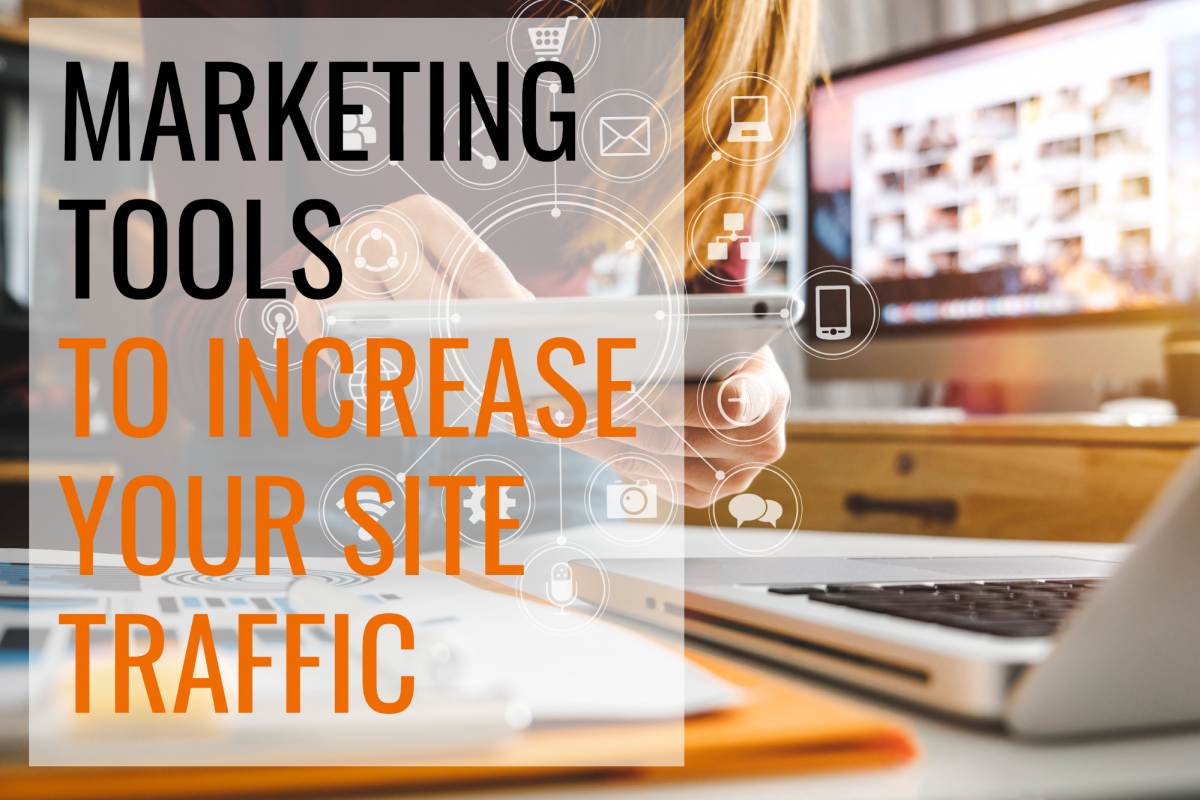With so many marketing tools available to choose from, knowing which are best for your business can feel a bit overwhelming. But it doesn’t have to be. This wealth of choice means that you can easily find a few easy to use options that can help to make life easier and help you reach your marketing goals.
The best marketing tools lead to an increase in traffic, and more importantly, an expansion in your conversion rates and sales.
In this article, we’ll take a look at a few marketing tools that you can use to both draw in relevant traffic and boost your conversion rates.
6 Powerful Marketing Tools
First up, let’s look at a few different types of tools that you’ll want to think about investing in.
Each marketing tool or platform delivers its own metrics and performance enhancement data, and from this insight, you can easily reach your marketing goals.
- Keyword Research Tools – The right keywords help your site to appeal to search engines and searchers alike, allowing you to draw in relevant traffic. SEO platforms provide an extensive amount of information on the success of a keyword, such as customer locations and usage time, and lead to huge click-through rates. Tools like Surfer SEO or MarketMuse are tremendously helpful with this.
- Conversion Rate Optimization (CRO) Tools – As an aspect of SEO, or a complement to it, these tools can help you to boost your conversion rates. Tools like Mixpanel can help you see who did what on your website, while Smartlook records information from both web and mobile usage of your site.
- Market Research Tools – Market research is crucial, and the cost is worth the quick outcome and results it leads to. All it takes is to understand what your clients are looking for, how to mold your branding to suit this need, and to use the insights gained from your analytics to identify and guide new improvement opportunities for your business. Tools like Questback can give insight into marketing data that you may have otherwise missed, and a platform like Key Survey uses visitor feedback to help you gather meaningful information that can refine your business.
- Site Performance Tools – It’s important to regularly audit the performance of your website. This can be done with performance measurement tools such as those offered by companies like Ahrefs or Supermetrics.
- Website Design Tools – Design is an important feature for any online business. It’s also something that you control and that can make a powerful difference at all stages of the business cycle. You should continuously make the appropriate changes to your site to optimize its performance. Make your digital design more responsive to customers and their browsers to optimize your visitor experience and improve your conversion rates. Every digital business or e-commerce site now requires a continuous approach to its basic design, both to improve performance, and track every one of these improvements. Most e-commerce startups today use a platform like Shopify or WordPress’ WooCommerce tool for an all-in-one solution.
- Email Marketing Tools – Some digital platforms, like Mailchimp for example, help you to increase your website traffic through email newsletters, along with a wealth of data that you can use to reach your subscribers. Mailchimp even offers built-in analytics to track the click-through and conversion rates of your readers. If you find the audience isn’t responding to your approach, find a new way to deliver your message.The key to using marketing tools successfully is learning about what works and what doesn’t, and adjusting your approach to gain the results you ultimately want. Start by identifying your target audience, and looking to understand your customers first, and then use the tools to meet them where they’re at.
KPIs Every E-Commerce Store Should Measure
To measure your website’s performance, and to see how relevant your traffic is, you need to find key performance indicators (KPIs) that you can track. Here are a few KPIs that are useful when it comes to measuring site traffic, and conversions.
- Interactions Per Visit – This gives you insight into each interaction on your website that is made by an individual visitor.
- Dwell Time – This is the time a user spends viewing your content after clicking a link to access it.
- Average Session Duration – The average duration of time that someone spends on content is 2-3 minutes.
- Bounce Rate – This is the percentage of website visitors who enter the site and then immediately leave.
- Traffic by Source – There are three sources from which a customer can access your content: direct, referral, or search. Analyzing where your customers are coming from can help develop more efficient marketing content.
- Organic Traffic/Domain Authority/Search Rankings – Organic traffic is dependent on the natural web algorithm; improving your keyword usage to refine your position in search rankings leads to domain authority.
- Conversion Rates – The process which changes a visitor into a customer. It’s not just about visitors, it’s about how many of those visitors convert.
Ideally, your KPIs should be connected to your big-picture goals. If they’re not things that are going to be moving the needle in some way, then they’re just vanity metrics. So choose relevant KPIs that will help you to track your progress.
My advice is to set up a spreadsheet and begin to map your metrics. If something isn’t bringing in the results you anticipated, then have a closer look at opportunities missed and think about how you can reach customers at that conversion point.
Powerful Marketing Tools
You need to know who your visitors are, where they’re clicking, and who’s sticking around to browse your digital space. Once you’ve organized the metrics you need for the basic foundation of your business, you’ll know what tools you need to connect with the market and drive traffic.
Here’s a look at some helpful options now:
Google Analytics

(Source: Google Analytics)
Google Analytics is one of the most widely used platforms for web analytics. It’s free, and makes it easy for you to analyze in-depth detail about your website visitors. In addition to website traffic, you can also monitor your advertising ROI, marketing efforts, and social networking sites as well. See more.
SEMrush

(Source: SEMrush)
I talk about SEMrush often because it’s an excellent SEO tool. It always seems to have just what you need. This platform’s critical capability allows you to analyze competitor websites and traffic as well as your own, and it allows you to compare your current and potential keywords against your competitors’.
This platform allows you to look at your competition, to see what they’re doing, what’s working for them and what’s not. It’ll help you to increase your site visits and will help you to develop a successful and advertising plan. Some of SEMrush’s best features include competitive analysis, keyword research and ranking, site auditing, and more. Instead of just identifying keywords that are used for searches, this tool will help you to find keywords that are the most profitable. It’s an option that’s definitely worth checking into.
HubSpot

(Source: HubSpot)
HubSpot features a host of traffic-generating tools. It divides its metrics and performance management tasks into four different groups. The Marketing Hub is aimed at lead generation and automation of customer response tools. The Sales Hub focuses on sales prospecting and sales channel metrics The Service Hub ties the outward facing metrics to knowledge management inside your business. And the CMS Hub, which is the content management automation function that brings customers and business together. Lastly, HubSpot’s ‘Grader tool’ offers excellent functionality and clear metrics to check your site performance.
Get our Marketing Tools to Increase Your Site Traffic delivered right to your inbox.
Mailchimp

(Source: Mailchimp)
Mailchimp is an email marketing platform that packs a punch. It’s a great tool for driving traffic using email campaigns.
They offer loads of features that makes it easy for you to reach your audience more effectively. For instance, you can use pop-ups to collect details from your contacts, or look for patterns and use that insight to start new campaigns. You can also segment your list by characteristic or behavior, allowing you to send out custom messages that meet them exactly where they’re at.
Piwik Pro

(Source: Piwik Pro)
Piwik Pro is a smaller company, but one that looks promising. This website analytics platform delivers performance measurement for site and mobile data. It offers some powerful tools, a nice dashboard, and visualization of metrics for team and product specializations. Piwick Pro adds new capabilities to share data to help increase customer engagement.
Hotjar

(Source: Hotjar)
Linked to your e-commerce or digital business, the Hotjar platform offers interaction mapping, or ‘heatmaps’, which clearly demonstrate how people use your site. It’s a cheap and cheerful platform that’s handy for seeing where people are spending time on your site, and what they’re clicking on the most. It also records a site-based transactional analysis that describes browser and buyer behavior. Hotjar even adds customer feedback and live response forms that build data pathways for your measured site performance. See what people are saying.
Optimizely

(Source: Optimizely)
Optimizely is a test tool, that allows you to build and run A/B tests on your site. This makes it easy for you to improve your conversion rates. You can create a variety of Optimizely experiments for your webpages using the dynamic or basic features that come with the service. This platform helps you target your messaging, personalize outbound marketing campaigns and test what messages, imagery, and promotions increase conversion, retention, and lifetime value of a customer (LTV).
Marketo

(Source: Marketo)
Marketo is marketing automation software that makes it easier for you to manage your marketing campaigns. This platform offers a complete marketing automation solution for lead management. Marketo also connects marketing and sales performance to create personalized customer experiences, improve visual content design, and measure business impact across every channel.
Pipedrive

(Source: Pipedrive)
Pipedrive is a newer player in market measurement, with lots of smart features for improving your performance using metrics.
Bonus Strategy: Site Optimization
Finally, keywords aren’t the only way to optimize your site. Another important part of optimization includes improving speed load time and resolving issues on your site. Setting up alerts and monthly reports in Ahrefs or another site optimization tool is a smart move. This will show you what’s bogging down your site, and save you from having to remember to research it yourself.
While you’re at it, you’ll also want to look at what plugins may be slowing your site down. WordPress and Shopify are popular platforms that have a wealth of valuable plugins available, but some of these can cause your site to slow to a crawl. See if you have any that are slowing down your site.
Optimizing for mobile visitors is especially important, as a significant portion of your visitors are likely to be mobile visitors. These visitors will click away, and fast, if a website’s loading slowly. According to one Google study, 53% of mobile visitors will leave a page that takes longer than three seconds to load.
Download your FREE worksheet to see more tips for optimizing your website, and your page load times.
Get our Marketing Tools to Increase Your Site Traffic delivered right to your inbox.
By investing your time and your available resources into designing and optimizing your business alongside these metrics, you’re ensuring not only the future success of your business, but also the present attention and consideration to the needs of your customer. Knowing what’s best for your business comes down to knowing what caters most effectively to your audience, and then working to implement the things that will draw them in, give them what they’re looking for, and help them on through to the point of conversion.
Still feeling overwhelmed? For marketing performance that drives business, you need a strategy and plan. Reach out today for your free 20-minute consultation. Let’s find a way to scale your business.







